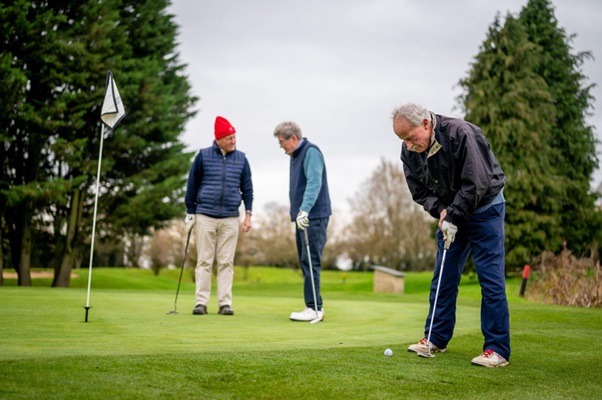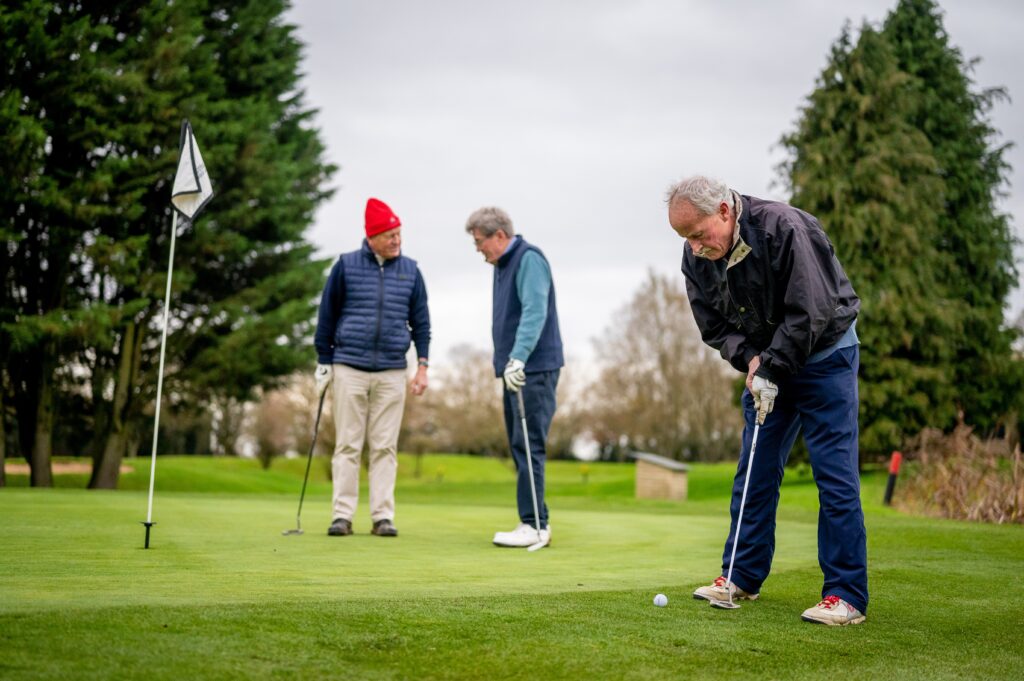Golf is a sport for all ages and skill levels. But as we get older, our bodies begin to change and might prevent us from playing golf as well as we once did. Dealing with sore joints and other physical limitations can be frustrating. However, there are some simple ways to improve your golf swing, even if you’re a senior. Here are some tips for seniors who want to keep playing the game they love:
1. Warm Up Properly
Warming up is an important part of any exercise program, and it’s no different for golf. A good warm-up will help you stay loose and limber, preventing you from pulling or straining muscles or tendons during your round. You should also warm down after each round to avoid cramping or stiffness. It’s not just a matter of comfort — if you don’t stretch out properly after playing, you could make existing injuries worse by not allowing them time to heal between rounds.
2. Use the Right Equipment
Golf clubs come in different sizes designed specifically for seniors — they’re lighter than standard clubs and have shorter shafts that make them easier to swing without pain or discomfort in your hands, wrists, and shoulders. If your current set doesn’t feel right, consider upgrading them before your next game.
3. Work on Your Posture
One of the first things you’ll notice about any professional golfer is how they stand while playing. They maintain perfect posture while they’re swinging, which helps them make consistently good shots.
A good posture is just as important for seniors as for younger players. Maintaining good posture when you’re out on the course is difficult, but it can be practiced inside and outside the golf course. When you practice with a trainer or at home, focus on keeping your shoulders down and back and keep your chest up so that it doesn’t slump forward or cave inwards. This will help you improve your swing by giving you more control over where the club head goes at impact with each swing.
4. Practice Regularly With a Trainer
If you want to become a better golfer, get in the habit of practicing on the course. It’s important that you practice regularly so that you can get used to hitting balls from various positions on the course. If possible, practice hitting balls from different lies (when the ball is not lying flat).
This will help you develop good habits during play when trying to figure out how best to approach a shot placed in an awkward position or under pressure from other players. You should also practice hitting shots off the tee when there’s no one around — this will help you correct bad habits before they become hard-wired into your swing mechanics.
5. Find a Local Course With Shorter Holes
Seniors should stick with courses with shorter holes — preferably under 100 yards — because they’re easier on aging joints and tendons. These courses also tend to be lower-priced than longer ones, which means more bang for your buck when it comes time for greens fees and equipment purchases.
6. Check On Online Golf Lessons
If you’re looking for extra help with your game, there are plenty of ways to get it. One of the most popular resources is a power loading golf swing online lesson. Many websites offer these videos, and they vary in price and quality. Some are free, while others cost money or require a subscription fee. If you’re looking for something simple, check out online lessons from professionals and try them out from the comfort of your home.
7. Make Sure Your Grip Is Correct
The most important thing to remember when learning to improve your golf swing is that there is no one right way to do it. Each person has a unique swinging style, which makes playing much more fun! However, there are some basic things that every player should know about how their grip should be positioned on the club. Each player must check their grip before hitting any shots because this will prevent injury during play and increase accuracy in hitting the ball!
8. Toes Opened to Reduce Hip Pain
The greatest thing to do while setting up is to slightly expand the toes if you require a golf swing to prevent hip strain.
Although a square stance with your toes pointed straight ahead is ideal, the fact that you are hurting can indicate that your swing is using too much torque.
You can see the toes fan out a little to relieve strain on the hips even when you look at some of the greatest professional senior golfers who have ever played the sport. To relieve the strain, make this movement without going overboard.
9. Get after it and tee it up higher
Numerous older golfers attempt to tee the ball low and push it as far down the fairway as they can. This is does not work.
To send these massive 460cc drivers flying, you must tee them up high, place them at the front of your stance, and make the biggest possible swing. Maintaining extended arms and allowing for a lengthy and broad follow-through are two of the greatest golf driver tips for elders.
You will want to repeat this extension in your swing if you can feel it a few times, due to its efficacy.
10. Improve Your Wrist Action
Senior golfers will perform significantly better on the course if they can learn to release the club. There is typically a range when looking at a senior golf club distance chart. Golfers who use wrist motion in their swing are at the higher end of that spectrum.
Pay attention to whether or not your wrists are rolling over, squaring the clubface, and finally releasing it as you swing the club down.
If you manage to hang on during impact, you probably struggle with a slice, which might result in significant distance loss.
11. Balance the Weight in The Feet
Your legs, hips, and shoulders are the most crucial muscles for golf swing speed. However, you must have a balanced weight to start with in order to have these muscles operating the way we need them to.
Senior golfers frequently inquire about where to place their weight at the start of their swing. A balanced setup is crucial for the majority of players.
Senior players occasionally place their weight on their toe or heel, which seriously affects their balance.
Make sure that your weight is evenly divided between your left and right feet and that it is also supported in the middle of each foot. When practicing chip shots, experiment with this idea to observe the difference it may make.
12. Make your arms feel heavy as you round the greens
Allowing the arms to feel heavy around the greens is one of the finest golf swing suggestions for the short game I have ever given to seniors. It is much simpler to knock down and through the chip shots when your arms are feeling a little heavier.
When they are close to the greens, keep an eye on the professional golfers. The golf club is not being swung about as if it were light and swiftly flying.
They move with intentional intention, have a precise pace, and consistently make touch with the ground. One of the many tiny mental game tactics that can help you become a much better short-game player is this one.
13. Regular Workout
To navigate the golf course, it is necessary to maintain your fitness. Spend three to five hours per week going for brisk walks. These may be hikes or power walks. If you would rather be in the water, swimming is also a choice.
The more experienced members of my crew also advise including cardio and core activities in your training program. Planks are a quick and portable core workout that can develop your balance and posture.
On the golf field, you will undoubtedly experience more weariness if you are out of shape, which will affect your power, rotation, and pleasure in the game.
14. Eat healthy
Your flexibility declines with age, which affects how you swing the golf club. You should thus concentrate on consuming foods like fish, poultry, blueberries, almonds, and avocados that improve your flexibility.
The National Council on Aging also advises increasing your consumption of lean protein-rich meals since older persons need more protein to maintain muscle mass than younger adults do. Beans, seafood, and brown rice are a few examples.
Consider including broccoli, tomatoes, carrots, and red cabbage in your dish as well.
Gary Player, one of the most talented PGA professionals, adheres to these principles and follows a rigorous training and fitness regimen. He is adamant that this regimen is essential to his successful lifespan and healthy aging.
15. Maintain Momentum
You must always keep in mind that golf is a mental game. You miss chances to advance if you are caught in the past, thinking back on shots that used to come easy to you.
Attack the course like a seasoned senior, instead. Make a strategy for the course you are playing and visualize your shots. At your playing level, planning where you want to place each shot can help you score at a much greater level.
Do not undervalue the importance of dressing the role. You may put yourself in a similarly optimistic frame of mind by wearing the appropriate golf attire!
16. Boost your foundational skills
The essentials are last but not least. They have that name for a reason, and they are always in vogue. They will last a lifetime if you pay special attention to them every time you practice.
Get a strong foundation, “Grip, stance, and proper posture are all very important.”
17. Keep Hydrated on the Course
Although it would seem obvious, it is surprising by how few golfers drink enough water while playing a round. Your body temperature and optimal water intake are influenced by these factors.
Golfers in a mild climate, however, are advised to drink up to 66% of their body mass in water each day. If you weigh 170 pounds, you should aim for drinking about 112 ounces of water each day.
Bottom Line
Taking up a new sport during retirement may be one of the most rewarding physical activities you can do. Whether you’re already retired or still working, it’s never too late to turn back the clock, exercise more, and improve your athleticism.



